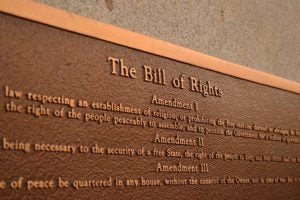
Learning Objectives
Students will understand that all people have rights and describe the importance of them.
Grade Levels
3-5
National Council for the Social Studies Standards
6-Power, Authority, and Governance
Materials Needed
Copies of the Bill of Rights (one for each student)
Lesson
Introduction
- Ask your students if they know what a right is.
- Explain that a right is something that is given and cannot be taken away.
- Ask your students about some rights that they have.
- List the rights that they say on the board.
Explicit Instruction/Teacher Modeling
- Why do we have a Bill of Rights?
- When people began discussing the idea of creating a government and the Constitution was being written, people got very nervous that the government would take too much power and people would lose important rights.
- A Bill of Rights was created so that people could have protection; even from the Government if necessary.
- Because of the Bill of Rights, we enjoy many freedoms that other countries do not have. What are some things we are free to do that some people in other countries are not?”
- Students might come up with freedom of religion, freedom to say what you think about the government, freedom to have a jury trial, freedom to have your privacy protected, the necessity of warrants, etc.
- Pass out the copies of the Bill of Rights. Ask students if they have heard of some of these before. Discuss. Go over what each amendment means.
Guided Practice/Interactive Modeling
- Over the years, people have considered whether or not pets, such as dogs, should have rights too.
- What rights do you think a dog should have?
- Have students give you ideas and write them on the board.
- The Government Relations team at American Kennel Club works to protect the rights of dog owners. You can find out more about the issues they are dealing with on their website (akcgr.org) and add them to the list on the board.
Independent Working Time (30 minutes)
- Have students work with a partner to choose one of the ideas from the board or come up with another.
- Students should create a display of the “right” they’ve chosen to highlight. It should include the right, which should be written with similar language as the original rights. It should also include an image that represents it and an explanation of why they think this right is necessary.
Review and Closing
- Allow students to share their rights.
References
AKC Government Relations. (n.d.). Retrieved from www.akcgr.org.

